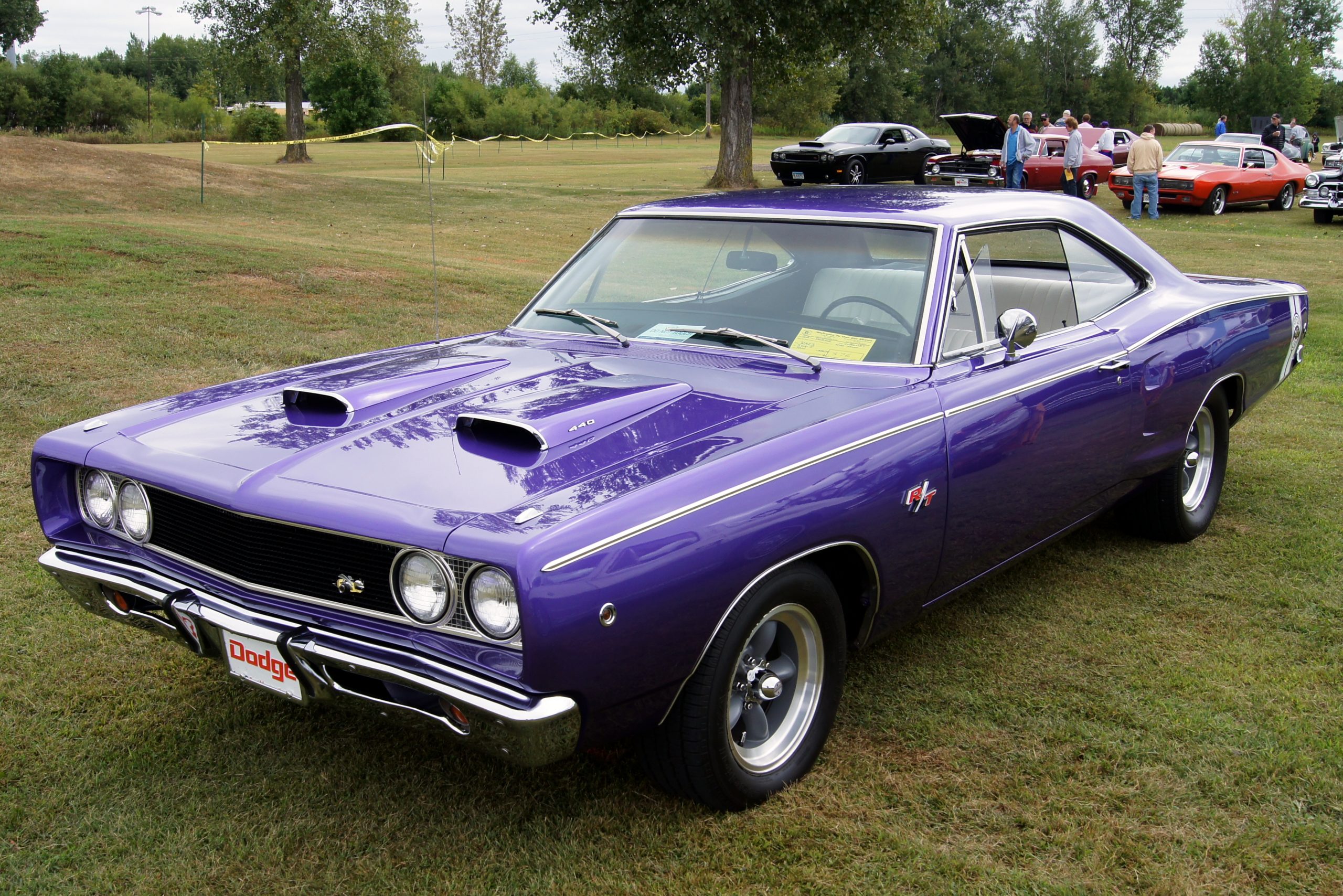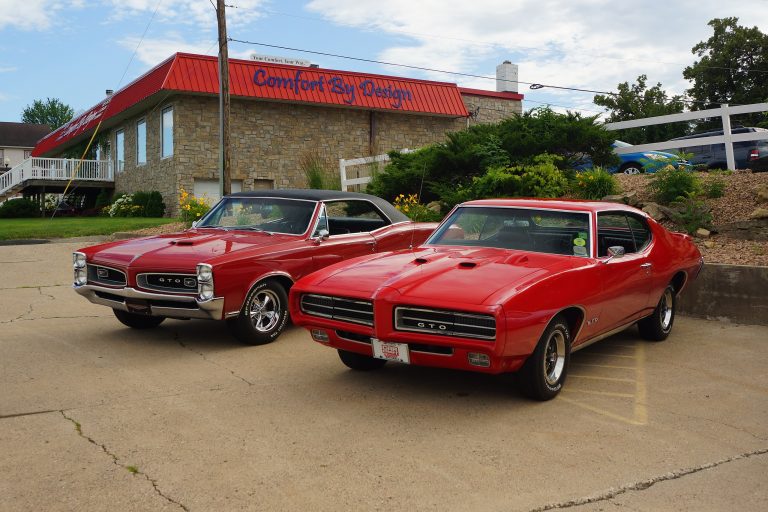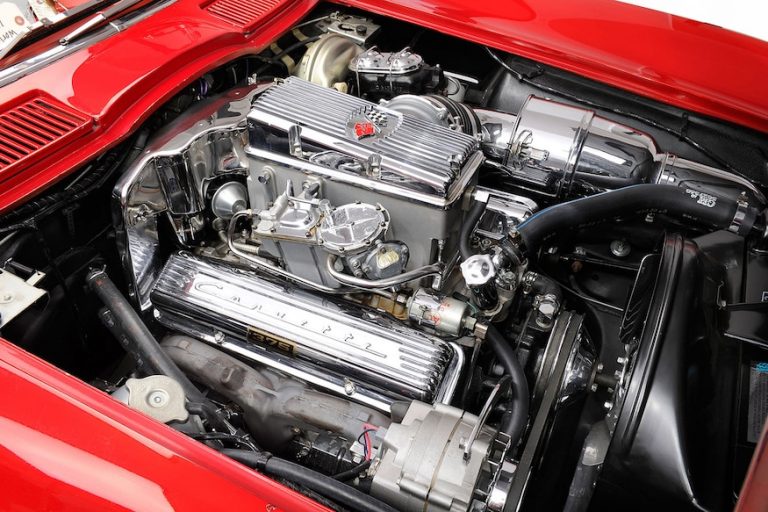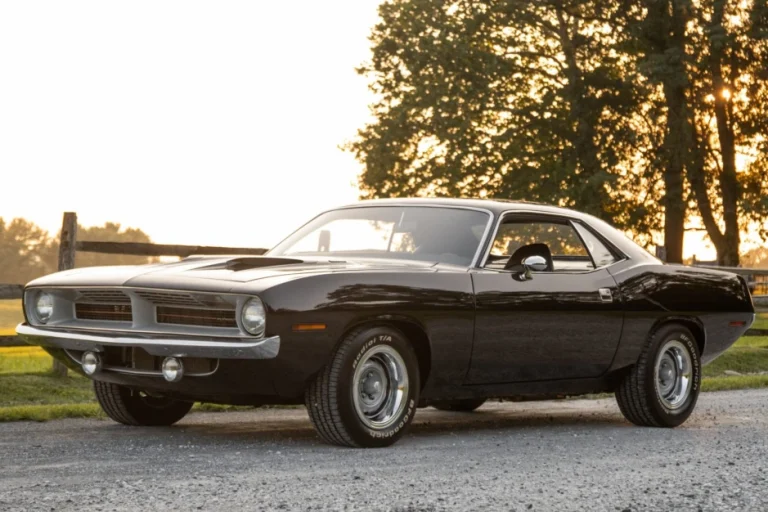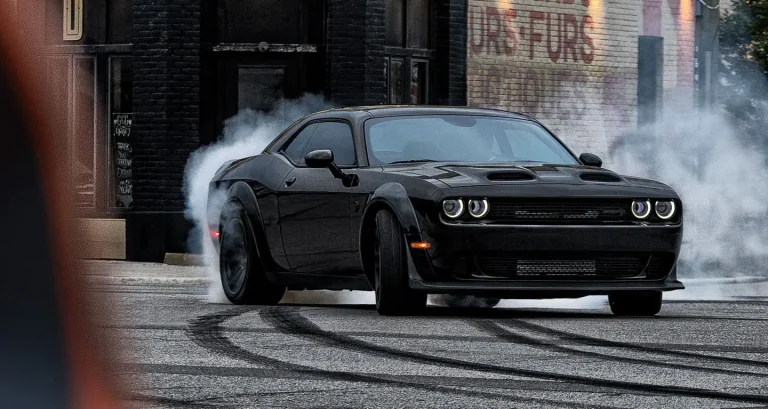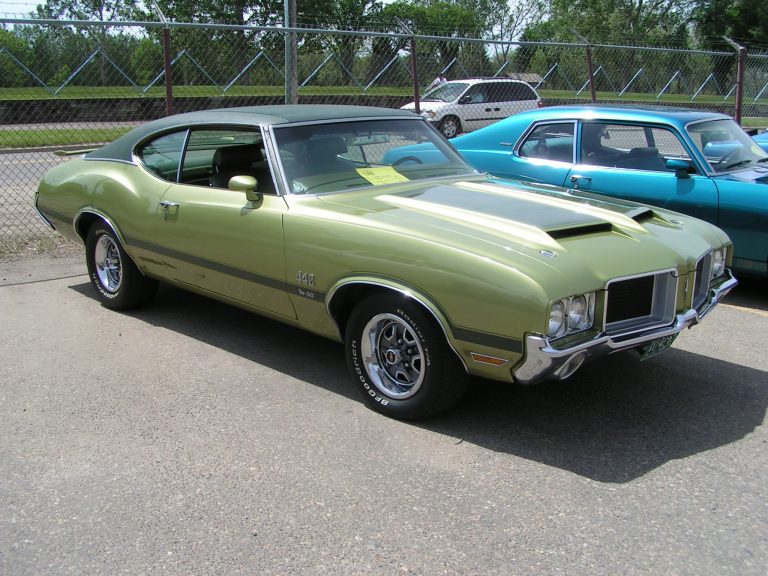Dodge Coronet

Meet Chandler
Chandler has a bachelors and masters degree in history as well as a passion for classics and muscle cars. His education and historical knowledge makes him skilled at crafting highly detailed articles about America’s muscle cars and automotive history. His love of muscle cars is undeniable, with him seeking them out at every opportunity during his visits to auto shows and car meets. Chandler’s knowledge and enthusiasm towards automotive history make him a great asset to the Muscle Car Club community.
Spanning two different eras from the 1940s through the 1970s, the Dodge Coronet is one of the most iconic cars of all time. It started life as a top of the line passenger car in 1949, but in the late-’50s Dodge started to stuff powerful V8 engines under the hood that could boast more than 340 horsepower, creating some of the earliest muscle cars. Though it had a brief hiatus from 1960–1964, the Coronet came roaring back in 1965 with even more powerful big-block, HEMI V8s, that pumped out more than 400 horsepower. Today, the Dodge Coronet is one of the hottest vehicles on the collectors market, especially the Super Bee and R/T models from the late 1960s. Read on to find out everything about the 1949–1976 Dodge Coronet.
Dodge Coronet Overview
In all, the Dodge Coronet spanned a total of 23 model years from 1949–1976. The first four generations lasted from 1949–1959, the fifth generation from 1965–1970, and the final sixth generation was in production through 1976. It’s hard to really call the Coronet much of a muscle car before 1956. That year, the Coronet first broke 200 horsepower with a 315 cid V8 engine, and offered power all the way up to 295 horsepower with the legendary D-500-1 engine.
The original Coronet only lasted until 1959, but it went out with a bang. Dodge put their new 383 cid V8 inside the 1959 Coronet, where it made 345 horsepower. Even though sales were still pretty strong, Dodge decided to retire the Coronet from 1960–1964.
However, they revived the Coronet in 1965 as a muscle car, and it would last through the 1976 model year. For its revival, Dodge gave it the same 383 big-block V8, but the real power plant was the 426 HEMI. This was the most powerful Coronet engine ever, making 425 horsepower and almost 500 lb-ft of torque. From 1967–1970, Dodge offered the Road/Track (R/T) version of the Coronet. The Coronet Super Bee soon joined from 1968–1970, and these were some of the best Coronets to ever leave the factory.
The final generation of the Coronet saw its decline, both from performance and production standpoints. Due to emissions, the V8 engines had to drop their power outputs, which made the Coronets much less desirable. This partly caused production to plummet, and Dodge renamed the Coronet the Monaco for 1977.
1949–1959 Dodge Coronet
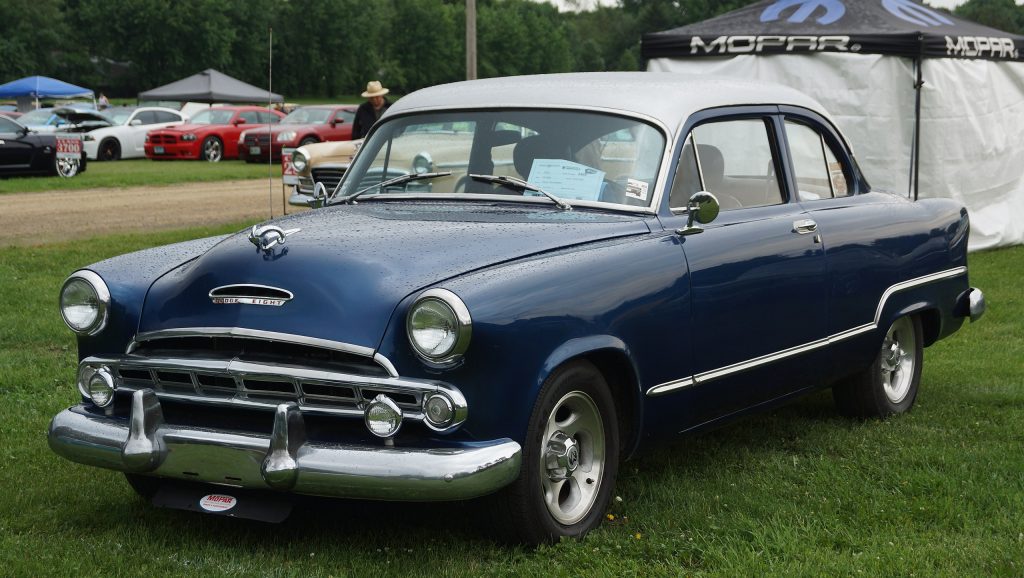
The 1949 Dodge Coronet was one of Dodge’s first postwar vehicles, with them restarting production in 1946. The Coronet was a luxury car part of Dodge’s “Royal Family” of cars, which included the Meadowbrook and Wayfarer. The Coronet was the top trim option and was also the biggest on its 123 ½ inch wheelbase. Dodge offered the 1949 Coronet in several different body styles, including a four-door sedan, six-passenger Club Coupe sedan, four-door station wagon that sat either six or nine, four-door Town sedan, six-passenger convertible, and a six-passenger sedan.
The coronet looked the same as the Meadowbrook on the outside, with taillights inside the fin-style fenders and a brake light in the license plate housing on the deck lid. In 1950, the Diplomat two-door replaced the Town Sedan. The car otherwise looked the same except for a new grille, and Dodge began offering both metal and wood versions of the wagon. Dodge again restyled the front end in 1951, making the hood more bulged and curved.
In 1952, the station wagon became the Sierra Wagon. A significant redesign came in the 1953 Coronet, which included the “jet-flow” hood scoop near the hood emblem, a curved windshield, wraparound rear window, new grille, and Coronet script on the front fenders. For the 1954 Coronet, Dodge introduced the two-door, six-passenger Suburban model, and in the 1955 Coronet, Dodge introduced the two-door, six-passenger Lancer.
1955–1959 Dodge Coronet
In 1955, the first inklings that the Coronet would be a muscle car started to appear. That year, Dodge gave it a 270 cid V8 with a four-barrel carb making 193 horsepower, but things got even more serious the next year. For the 1956 Dodge Coronet, Dodge introduced the D-500 and D-500-1 engines, which are the first Coronet muscle cars. The Coronet was one of Dodge’s primary vehicles during the 1950s horsepower wars, when they were building muscle cars before the moniker really existed.
The 1955 Dodge Coronet received a six-inch bump in length, new split-grille, simulated hood scoop, and new taillights. Added for 1956 were new rear fenders with tail fins, which would only get bigger and more exaggerated. For the 1957 Coronet, Dodge made the body longer, lower, and wider. They revamped the suspension with a new front torsion bar, and used recessed headlights with brows, a new grille, and a chrome strip on the side.
From the top Dodge trim in 1949, the Coronet dropped to the intermediate trim in 1954, and to the base Dodgetrim option from 1955-on. Dodge discontinued the Coronet after 1959, but it would only be a few years until they brought it back, this time as a genuine muscle car.
1949–1959 Dodge Coronet Engine Technical Specifications
| Model Years | Engine | Horsepower | Torque |
| 1949-1958 | 230 cid I6 (1bbl) | 103-138 horsepower | 190-208 lb-ft |
| 1953-154 | 241 cid V8 (2bbl) | 140-150 horsepower | 220 lb-ft |
| 1955 | 270 cid V8 (2bbl) | 175 horsepower | 240 lb-ft |
| 1955 | 270 cid V8 (4bbl) | 193 horsepower | 245 lb-ft |
| 1956 | 270 cid V8 (2bbl) | 189 horsepower | 266 lb-ft |
| 1956 | 315 cid V8 (2bbl) | 218 horsepower | 309 lb-ft |
| 1956 | 315 cid V8 (4bbl) | 230 horsepower | 316 lb-ft |
| 1956 | 315 cid V8 (4bbl) (D-500) | 260 horsepower | 330 lb-ft |
| 1956 | 315 cid V8 (2x4bbl) (D-500-1) | 295 horsepower | 330 lb-ft |
| 1957-1958 | 325 cid V8 (2bbl) | 245-252 horsepower | 320 lb-ft |
| 1957-1958 | 325 cid V8 (4bbl) | 260-265 horsepower | 335 lb-ft |
| 1957 | 325 cid V8 (4bbl) (D-500) | 285 horsepower | 345 lb-ft |
| 1957 | 325 cid V8 (2x4bbl) (Super D-500) | 310 horsepower | 350 lb-ft |
| 1957 | 354 cid V8 (2x4bbl) (D-501) | 340 horsepower | 405 lb-ft |
| 1958 | 350 cid V8 (4bbl) | 295 horsepower | 385 lb-ft |
| 1958 | 361 cid V8 (4bbl) (D-500) | 305 horsepower | 400 lb-ft |
| 1958 | 361 cid V8 (2x4bbl) (Super D-500) | 320 horsepower | 400 lb-ft |
| 1958 | 361 cid V8 (EFI) | 333 horsepower | 400 lb-ft |
| 1959 | 326 cid V8 (2bbl) | 255 horsepower | 350 lb-ft |
| 1959 | 383 cid V8 (4bbl) (D-500) | 320 horsepower | 420 lb-ft |
| 1959 | 383 cid V8 (2x4bbl) (Super D-500) | 345 horsepower | 420 lb-ft |
1949–1959 Coronet Engines and Performance
For the first few years of the Coronet, the only available engine was a 230 cid slant-six engine that made 103 horsepower. It was called the “slant-six” because the inline engine was slanted towards the passenger side to allow for easier maintenance. Officially, Dodge called in the “Get-Away” Six.
Dodge gave the 1953 Coronet its first V8 engine, a 241 cid with a double-barrel they called the “Red Ram V-eight.” The Coronet Red Ram had the “Fire-Flash” hemi-style combustion chambers, which helped increase power over traditional cylinder heads. The double-barrel carb was a Stromberg WW3-108, and it produced 140 horsepower. In 1954, the Red Ram became a 270 cid V8, and the Super Red Ram was its quad-barrel cousin that made up to 193 horsepower.
In the 1956 Coronet, the Super Red Ram switched to the 315 cid V8 platform, making 230 horsepower with a Carter WCFB quad-barrel. However, that paled in comparison to the D-500 and D-500-1 versions of the 315. The D-500 had a higher 9.25:1 compression ratio and the same quad-barrel, making 260 horsepower. The D-500-1 had dual Carter WCFB quads, which bumped output up to 295 horsepower.
For the next year’s 1957 Coronet, Dodge dropped the 315 in favor of the larger 325 and 354 V8s. The 325 was now the Red Ram and D-500 engine, making as much as 310 horsepower with dual Carter WCFB quads in the Super D-500 package. The 354 HEMI V8 was the new D-501 engine, with 10.0:1 compression, hydraulic valve lifters, and two Carter WCFBs, producing 340 horsepower.
The Final Coronet Engines
In 1958, the D-500 moved to the new 361 V8, making either 305 horsepower or 320 horsepower in the Super D-500 guise. However, the real news was the 361 V8 that used electronic fuel injection courtesy of a Bendix EFI system. Also known as the Electrojector, it was a more efficient fuel delivery system that upped output to 333 horsepower, but was very unreliable and only lasted one model year.
For the final year of the original Coronet in 1959, Dodge gave it a big-block V8 engine, the 383 V8. This took over the D-500 and Super D-500 packages, making a high of 345 horsepower with dual quad-barrel Carter carbs.
The 383 powered 1959 Dodge Coronet is really the first true Coronet muscle car, as it finally got its big-block V8 engine. Unfortunately, it only lasted for one year, as Dodge did not see fit to continue producing it. Luckily, its hiatus was short lived, and the Coronet would soon return with a vengeance.
1949–1959 Dodge Coronet Production Numbers
| Model Year | Bodystyle | Production Total |
| 1949 | Coronet Four-Door | 144,390 |
| Coronet Two-Door | 48,646 | |
| 1949 Total | 193,036 | |
| 1954 | Four-Door Sedan | 50,963 |
| Two-Door Club Coupe | 12,499 | |
| Two-door Suburban | 9,489 | |
| Four-Door Sierra | 1,300 | |
| Two-Door Hardtop Coupe | 100 | |
| Two-Door Convertible | 50 | |
| 1954 Total | 74,401 | |
| 1955 | Four-Door Sedan | 46,704 |
| Two-Door Sedan | 24,104 | |
| Two-Door Lancer | 26,727 | |
| Two-door Suburban | 8,115 | |
| Four-Door Sierra | 5,952 | |
| 1955 Total | 111,602 | |
| 1956 | Coronet All | 142,613 |
| 1957 | Coronet All | 160,979 |
| 1958 | Coronet All | 77,388 |
| 1959 | Coronel All | 96,782 |
1965–1970 Dodge Coronet
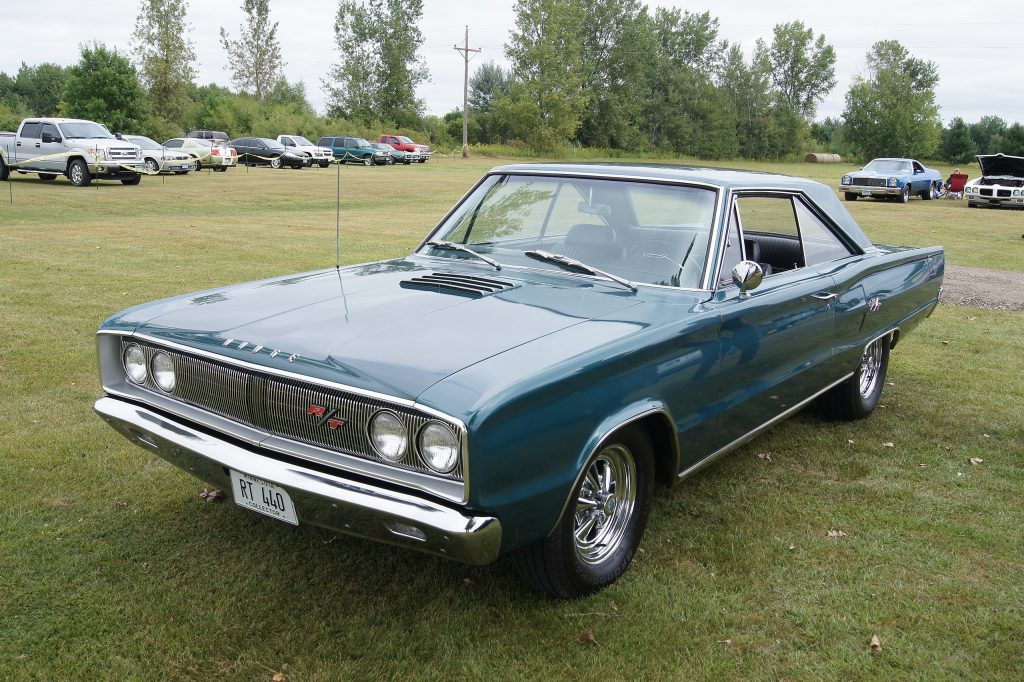
Dodge reintroduced the Coronet line in 1965, and it looked completely different. The Coronet now rode on the Chrysler B-body, which was the same platform as the Dodge Charger, Plymouth GTX, and Plymouth Road Runner, among others. Available trims were the base Coronet, intermediate Coronet 440, and top level Coronet 500. For the next year 1966 Coronet, Dodge made it an inch shorter but also wider, added a new mesh grille, and retained the quad-headlights inside the grille from the year prior.
The Coronet R/T and Coronet Super Bee
In 1967, Dodge replaced the base Coronet with the Coronet Deluxe, and also added the new Coronet R/T for performance enthusiasts. Dode gave the entire line a new rear-end design, and R/T got hood scoops, a larger battery, heavy duty brakes, upgraded suspension, and Red Streak nylon tires. For the 1968 Coronet, Dodge once again restyled the body, making it smoother and more rounded than before.
However, the big news for 1968 was the introduction of the now iconic Coronet Super Bee model. The 1968 Coronet Super Bee was basically a Coronet 440 with the 383 Magnum engine, a power-bulge hood, heavy-duty suspension, Hurst floor-mounted competition shifter, dual exhausts, and of course, the Bumblebee striping on the side.
Both the Coronet R/T and Coronet Super Bee lasted until 1970, when the fifth generation ended. Of the two, the R/T was definitely the more performance oriented. They both had upgraded suspension packages, but the R/T had access to the all-powerful 426 HEMI, as well as the massive 440 Magnum V8.
For the final fifth-generation 1970 Coronets, Dodge gave all of them a face lift with a new split-oval grille. Nineteen-seventy was also the last year the Coronet was a true muscle car. Performance severely dipped starting the next year, and would never recover. The Coronet still had big-block V8 engines, but much of the enthusiasm from before was gone, and sales cratered from 1971-on.
1965–1970 Dodge Coronet Engine Technical Specifications
| Model Years | Engine | Horsepower | Torque |
| 1965-1970 | 225 cid I6 (1bbl) | 145 horsepower | 215 lb-ft |
| 1965-1968 | 273 cid V8 (2bbl) | 180-190 horsepower | 260 lb-ft |
| 1965-1970 | 318 cid V8 (2bbl) | 230 horsepower | 340 lb-ft |
| 1965-1966 | 361 cid V8 (2bbl) | 265 horsepower | 380 lb-ft |
| 1965-1970 | 383 cid V8 (4bbl) | 325-335 horsepower | 425 lb-ft |
| 1965 | 426 cid V8 (4bbl) | 365 horsepower | 470 lb-ft |
| 1965-1970 | 426 cid V8 (2x4bbl) (Street-Hemi) | 425 horsepower | 490 lb-ft |
| 1966-1970 | 383 cid V8 (2bbl) | 270-290 horsepower | 390 lb-ft |
| 1967-1970 | 440 cid V8 (4bbl) (Magnum) | 375 horsepower | 482 lb-ft |
1965–1970 Coronet Engines and Performance
In 1965, Dodge gave the Coronet five outstanding power plants, the 273, 318, 361, 383 Magnum, and 426 HEMI V8s, adding another, the 440 Magnum V8, in 1967. Both the 273 and 318 V8s were part of the Chrysler LA series of engines. For 1965, the 273 had a 8.8:1 compression ratio, hydraulic valve lifters, and a Carter two-barrel BBD-3943S carb. The larger 318 had 9.0:1 compression, hydraulic lifters, and a slightly more powerful Carter BBD-3947S double-barrel carb.
The 361, 383, and 440 engines were part of the Chrysler B/RB series of V8s. For 1965, the B-series 361 had 9.0:1 compression, hydraulic lifters, and a Carter BBD-3849S double-barrel carb. The B-series 383 big-block had 10.0:1 compression, dual exhausts, five main bearings, and a Carter quad-barrel AFB-3855S carb. A two barrel version came out in 1966, which made about 50 horsepower less than the four-barrel version.
The Dodge Coronet 440 Magnum and 426 HEMIs
The largest engine available was the RB-series 440 Magnum, which Dodge introduced in the Coronet in 1967. Dodge’s 440 Magnum, called the Super Commando in Plymouths, was 440 cubic inches of 375 horsepower fury. It had 10.0:1 compression, wedge-style combustion chambers, hydraulic lifters, and a Carter AFB-4130S quad-barrel carb.
For 1970 only, Dodge made the six-pack version of the 440 available in the Coronet R/T. The 440 Six-Pack was a standard 440 Magnum, but with a slightly higher 10.1:1 compression ratio and a unique carb setup. The name six-pack came from the three Holley double-barrel carburetors Dodge combined to make a very powerful 6-venturi unit. This pumped horsepower up on the 440 Magnum to 390 horsepower, and also added 8 lb-ft of torque to total 490 lb-ft of torque.
The top dog was and always will have been the 426 HEMI. Known as the Hemi-Charger or Hemi Eight-Barrel when it first came out in 1965, in 1966 it switched to the now famous Street-Hemi moniker. For 1965, the 426 HEMI had ultra-high 12.0:1 compression, solid valve lifters, five main bearings, and dual Carter AFB-3084S quad-barrel carbs put together for a massive eight-venturi unit. It pumped out 425 horsepower and 490 lb-ft of torque, and required premium fuel.
Dodge Coronet R/T and Dodge Coronet Super Bee Engines
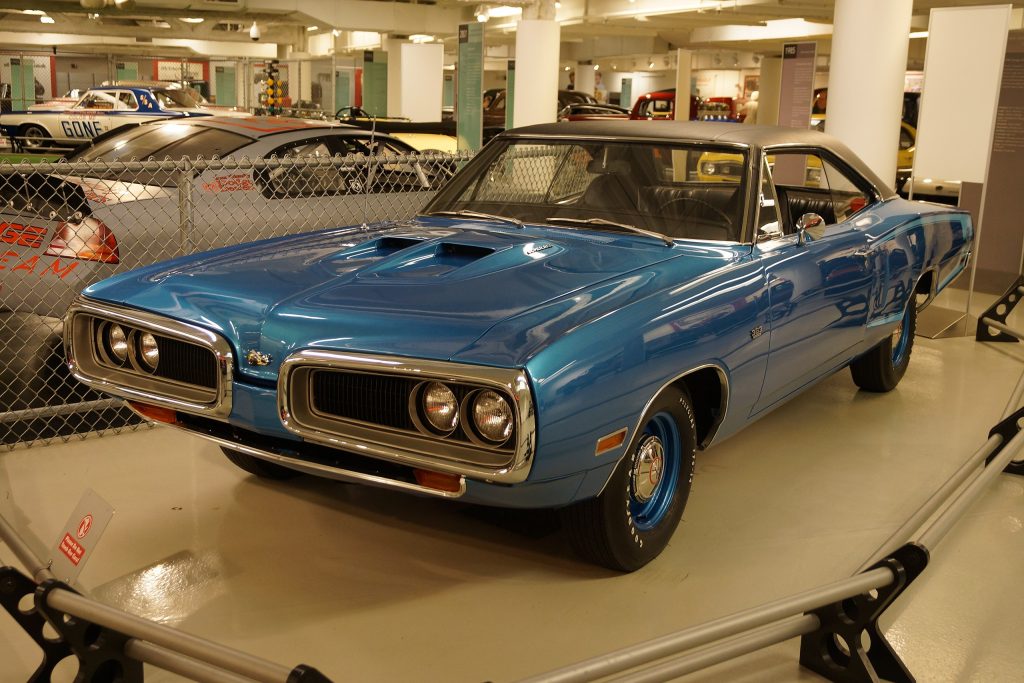
For its entire 1968–1970 run, the Dodge Super Bee was only available with the 383 Magnum V8 or 426 HEMI V8 engines. The Magnum 383 pumped out 335 horsepower, while the 426 HEMI made 425 horsepower.
For the 1967–1970 Coronet R/T, the only available engines were the 426 HEMI and the 440 Magnum. In 1970 only, Dodge made the Six-pack version of the 440 Magnum available, the only Coronet to get it. Both the 426 and all versions of the 440 dropped from the Coronet after 1970. In other vehicles, the HEMI only lasted until 1971, and the 440 dropped out after 1972, and by then it still pumped out 330 horsepower (Net) in the six-pack setup.
1965–1970 Dodge Coronet Production Numbers
| Model Year | Bodystyle | Production Total |
| 1965 | Coronet | 63,100 |
| Coronet Station Wagon | 25,600 | |
| Coronet 440 | 87,500 | |
| Coronet 500 | 33,300 | |
| 1965 Total | 209,500 | |
| 1966 | Coronet | 10,700 |
| Coronet Deluxe | 46,200 | |
| Coronet Station Wagon | 27,700 | |
| Coronet 440 | 110,600 | |
| Coronet 500 | 55,700 | |
| 1966 Total | 250,900 | |
| 1967 | Coronet Deluxe | 27,800 |
| Coronet Station Wagon | 24,200 | |
| Coronet 440 | 92,500 | |
| Coronet 500 | 29,300 | |
| Coronet R/T | 10,181 | |
| 1967 Total | 183,981 | |
| 1968 | Coronet Deluxe | 45,000 |
| Coronet Station Wagon | 33,100 | |
| Coronet 440 | 103,500 | |
| Coronet 500 | 30,100 | |
| Coronet R/T | 10,900 | |
| 1968 Total | 222,600 | |
| 1969 | Coronet Deluxe | 30,400 |
| Coronet Super Bee | 27,800 | |
| Coronet 440 | 105,900 | |
| Coronet 500 | 32,100 | |
| Coronet R/T | 7,200 | |
| 1969 Total | 203,400 | |
| 1970 | Coronet Deluxe | 14,566 |
| Coronet Super Bee | 15,506 | |
| Coronet 440 | 66,571 | |
| Coronet 500 | 15,697 | |
| Coronet R/T | 2,615 | |
| 1970 Total | 114,955 |
1971–1976 Dodge Coronet
The sixth and final generation of the Dodge Coronet spanned 1971–1976, and saw the car’s unfortunate decline. By now, the two-door and coupe offerings were all dropped, and all that were available were either a four-door sedan or four-door station wagon. New trim levels were the base Coronet, intermediate Coronet Custom, and top level Brougham and Crestwoods. The Broughams were sedans and the Crestwoods were station wagons, and had all the features of the Customs and then some.
Dodge still built the Coronet on the Chrysler B-body platform, which was now only slightly larger at 118 inches. The styling became even more rounded than before, the grille was no longer split, and it had subtle hints of the coke-bottle styling made famous from other muscle cars.
The Coronet was no longer a true muscle car by this point, even though it retained the 383 big-block V8 engine. It was now much more of a family passenger car, especially with the elimination of all coupes. Those looking for Dodge power could no longer look to the Coronet, and had to switch to the Dodge Charger, Dodge Challenger, or if you were desperate, the Dodge Dart was still respectable for 1971 with the 340 V8.
In 1975, Dodge once again offered a coupe version of the Coronet, and it was available at all trim levels. Visually, not much had changed since 1971, with the exception of a new front-end, split-grille, and taillights. The final 1976 Coronet ditched the split-grille (again), but otherwise looked basically the same. In 1977, Dodge replaced the Coronet with the Monaco, and it has not revived the Coronet moniker since.
1971–1976 Dodge Coronet Engine Technical Specifications
| Model Years | Engine | Horsepower | Torque |
| 1971 | 225 cid I6 (1bb) | 145 horsepower | 215 lb-ft |
| 1971 | 318 cid V8 (2bbl) | 230 horsepower | 320 lb-ft |
| 1971 | 383 cid V8 (2bbl) | 275 horsepower | 374 lb-ft |
| 1971 | 383 cid V8 (4bbl) | 300 horsepower | 409 lb-ft |
| 1972-1976 | 225 cid I6 (1bb) | 95-110 horsepower | 170-185 lb-ft |
| 1972-1976 | 318 cid V8 (2bbl) | 150 horsepower | 260 lb-ft |
| 1972 | 400 cid V8 (2bbl) | 190 horsepower | 310 lb-ft |
| 1972-1974 | 400 cid V8 (4bbl) | 250-260 horsepower | 330-340 lb-ft |
| 1973 | 400 cid V8 (2bbl) | 170 horsepower | 305 lb-ft |
| 1974 | 360 cid V8 (2bbl) | 200 horsepower | 290 lb-ft |
| 1974 | 400 cid V8 (2bbl) | 205 horsepower | 310 lb-ft |
| 1975-1976 | 318 cid V8 (2bbl) | 135-140 horsepower | 245-255 lb-ft |
| 1975-1976 | 360 cid V8 (2bbl) | 175-180 horsepower | 270-290 lb-ft |
| 1975 | 360 cid V8 (4bbl) | 190 horsepower | 270 lb-ft |
| 1975 | 400 cid V8 (2bbl) | 165 horsepower | 295 lb-ft |
| 1976 | 400 cid V8 (4bbl) | 195 horsepower | 285 lb-ft |
1971–1976 Coronet Engines and Performance
The only carryover performance engines from the fifth generation to the sixth generation Coronet were the 318 LA and 383 B-series of engines. The 318 lasted through 1976, but only made 140 horsepower in its final year. Compression was down to 8.5:1, and it used a less powerful Carter BBD-8086S double-barrel carb. The 383 only lasted one year in the sixth generation, and was dropped from the Coronet lineup from 1972-on.
In its place, Dodge put the 360 and 400 cid V8s in its place. First came the 400 V8 in 1972, which was from the same Chrysler B-series as the prior 361 and 383 V8s. For 1972 it had a 8.2:1 compression ratio, hydraulic valve lifters, and either a two or four-barrel Carter carburetor. The LA-series 360 V8 first became available in 1974, and had 8.4:1 compression, hydraulic lifters, and a two-barrel Carter carb.
The Decline of Horsepower
There are two main reasons that horsepower ratings declined on the Coronet (and all Dodge vehicles) beginning in 1971: emissions restrictions and SAE Net horsepower ratings. Increased emissions restrictions in 1971 led to drops in compression ratios and detuning, which made the engines much less powerful by the end of the Coronet’s run.
In addition, starting in 1971, manufacturers had to start listing horsepower by SAE Net instead of SAE Gross standards. This meant the engine was tested with accessories that caused parasitic loss, much like when installed in a car, which is supposed to give more realistic horsepower ratings. Compared with SAE Gross, SAE Net horsepower ratings sometimes chopped 60-70 horsepower away. The ratings didn’t affect actual performance on the street, but looked much less powerful to the eye.
It was an imperfect ending to such an iconic car, and hopefully Dodge will revive the Coronet in the future and make it into a high performance machine once again.
1971–1976 Dodge Coronet Production Numbers
| Model Year | Bodystyle | Production Total |
| 1971 | Coronet | 17,264 |
| Coronet Custom | 48,899 | |
| 1971 Total | 66,163 | |
| 1972 | Coronet All | 54,425 |
| 1973 | Coronet | 19,269 |
| Coronet Custom | 59,509 | |
| Coronet Crestwood | 8,755 | |
| 1973 Total | 87,533 | |
| 1974 | Coronet Custom | 55,599 |
| 1975 | Coronet | 11,608 |
| Coronet Custom | 41,893 | |
| Coronet Brougham | 9,975 | |
| Coronet Station Wagon | 8,019 | |
| 1975 Total | 71,495 | |
| 1976 | Coronet | 15,732 |
| Coronet Brougham | 12,831 | |
| Coronet Crestwood | 3,246 | |
| 1976 Total | 31,809 |
Dodge Coronet FAQ
The Dodge Coronet had relatively high production figures, and is one of the more available cars on the collectors market today. Dodge built more than 1.1 million Coronets from 1965–1970 alone, which are the most sought out years. However, the production of Coronet R/T and Coronet Super Bee models is much lower, making them much more rare.
The Dodge Coronet is similar to the Dodge Charger, but is not the same. They both rode on the same Chrysler B-body and had similar engine options, but looked slightly different and the Charger still had good performance after 1971.
Yes, the Dodge Coronet is a muscle car, depending on the year and engine. In the late-1950s, Dodge gave the Coronet high performance V8 engines, making some of the first muscle cars. In the 1960s, the Coronet R/T and Coronet Super Bee were some of the best muscle cars ever created.
In 1970, Dodge produced 114,955 Dodge Coronets of all body styles. This included 14,566 Coronet Deluxe; 15,506 Coronet Super Bee; 66,471 Coronet 440; 15,697 Coronet 500; and 2,615 Coronet R/T.
The Coronet 500 was a higher trim version of the Coronet 440. The Coronet had all of the accessories of the 440, but added more luxury items.
Dodge Coronet Super Bee and R/T FAQ
For its entire 1968–1970 run, the Dodge Super Bee was only available with the 383 Magnum V8 or 426 HEMI V8 engines. The Magnum 383 pumped out 335 horsepower, while the 426 HEMI made 425 horsepower.
For the 1967–1970 Coronet R/T, the only available engines were the 426 HEMI and the 440 Magnum. In 1970 only, Dodge made the Six-pack version of the 440 Magnum available, the only Coronet to get it.

